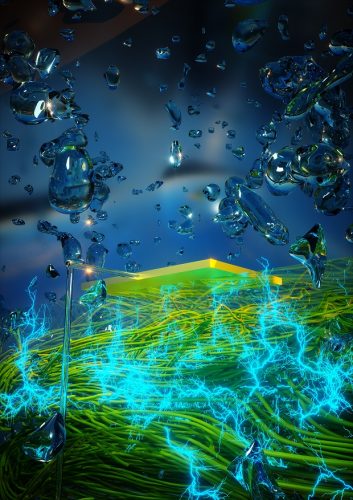Image courtesy of Ella Maru Studio.
The age of fossil fuels is nearing its end. But as the earth’s coal, oil, and natural gas reserves are being drained, there are many working to lay the foundation for the future of energy. Among them is a group that has found a way to harness massive amounts of power from moisture in the very air around us. Led by Professor of Electrical Engineering Jun Yao, a team of researchers at the University of Massachusetts Amherst recently invented a thin-film nanowire device that generates a self-sustained electrical current from ambient moisture.
Made from a combination of gold electrodes and a film of protein nanowires synthesized from the microbe Geobacter sulfurreducens, this device can create a stable current for roughly a day before self-recharging. Not only did preceding ambient moisture-based devices take far longer to recharge, but they could also only generate bursts of power that lasted less than a minute. While other moisture-based devices, much like solar panels or wind turbines, have geographical limitations to their use––such as the need to be near water––the nanowire generator works basically anywhere, even if the air is dry. The difference between the nanowire generator and other moisture-based technologies is a fundamental one: “The key is that this device has the magic to create a moisture gradient out of a non-gradient ambient environment,” Yao said.
The conception of this device could be considered serendipitous. “You could say that it was accidental,” Yao said. Initially, they sought to develop a simple biosensor that could provide a biomedical assessment of the amount of moisture in one’s skin. However, Xiaomeng Liu, a graduate student, forgot to plug the device into a power source. To their amazement, the researchers observed a sustained electrical current. Upon setting up the experiment again, they were able to reproduce the current. They immediately began untangling the mystery of the device’s mechanism.
As a kind of miniature cloud, the device’s exposed top interface is bombarded by water molecules, building up an intense charge. This creates separation of charge between the top interface and the bottom interface, which is sealed or buried. When the interfaces are connected, there is a discharge, analogous to a flash of lightning, giving rise to a flow of current––a phenomenon for which the nanowires are responsible. The small size of these nanowires allows the formation of a network of high-density pores, which establishes a moisture gradient in an ambient environment. This moisture gradient creates an ionization gradient, enabled by the charge separation, which in turn produces an electric field.
The main barriers to the widespread use of devices like this one are a lack of human and financial resources to conduct further research, as well as the transition to mass production of the nanowires from microbes. Nevertheless, Yao’s colleague, Derek Lovely, recently found a way to produce protein nanowires from E. coli, leading to a much faster turnaround in material production. Looking ahead, the lab has already applied for more federal funding and seeks to hire more researchers to connect many of these devices together. The goal is to achieve a compact, functional form, so as to maximize the technology’s potential.
According to Yao, the team hopes to set a new standard in the field. “[Normally], when we talk about green technology, that means the energy conversion [doesn’t] produce any toxic chemicals,” he said. “This is a green technology because the conversion part is certainly green, but the materials side is also green, [as it comes from] a biodegradable material, a protein.”
As our society continues to assess the best technologies to suit our energy needs in the future, it is imperative that we choose a route that does not further harm public health or the environment. Renewable energy generated from this moisture-based protein nanowire device could be just what we need.
Sources:
Liu, X., Gao, H., Ward, J.E., Liu, X., Yin, B., Fu, T., Chen, J., Lovely, D.R., Yao, J. (2020).
Power generation from ambient humidity using protein nanowires. Nature, 578 (7796), 550-554, doi: 10.1038/s41586-020-2010-9.
Renewable Energy Explained. (2019, June 27). Retrieved from https://www.eia.gov/energyexplained/renewable-sources/
Yao, J. (2020, March 7). Phone Interview.
Zavisa, J. (2020, January 27). How Lightning Works. Retrieved from https://science.howstuffworks.com/nature/natural-disasters/lightning.htm

